Hotspot Shield Review: Quick Expert Summary
Hotspot Shield is very fast, good for streaming, easy to use, and secure. Hotspot Shield has a big server network (3,200+ servers in 85 countries), allowing users all over the world to easily find nearby servers to get the fastest internet connection speeds — I had blazing-fast speeds on virtually every server I tested!
Plus, Hotspot Shield works with all of the popular streaming sites, including Disney+, Hulu, and BBC iPlayer. It can also access different libraries on Netflix and Amazon Prime.
Besides industry-standard VPN security features, Hotspot Shield also has:
- Split-tunneling.
- P2P support.
- Perfect forward secrecy.
- And more…
I like Hotspot Shield, but it has a few issues — for example, IPv6 and WebRTC leak protection only work on Windows, it doesn’t always work in restrictive countries like China, and oddly, its quick-connect feature only connects you to US servers (leaving non-US users having to manually connect to a local server). Plus, its 1-year deal is on the pricey side.
Hotspot Shield has a free plan as well as 1-month and 1-year paid plans, and backs all of the premium plans with a lengthy 45-day money-back guarantee.
| 🏅 Overall Rank | #15 out of 82 VPNs |
| 🌍 Servers | 3,200+ |
| 📱 Number of Devices | Up to 10 |
| 💸 Starting Price | $6.66 / month |
| 🎁 Free Plan | ✅ |
| 💰 Money-Back Guarantee | 45 days |
Try Hotspot Shield (45 Days Risk-Free)
Hotspot Shield Full Review — Fast, Secure & Provides Great Value
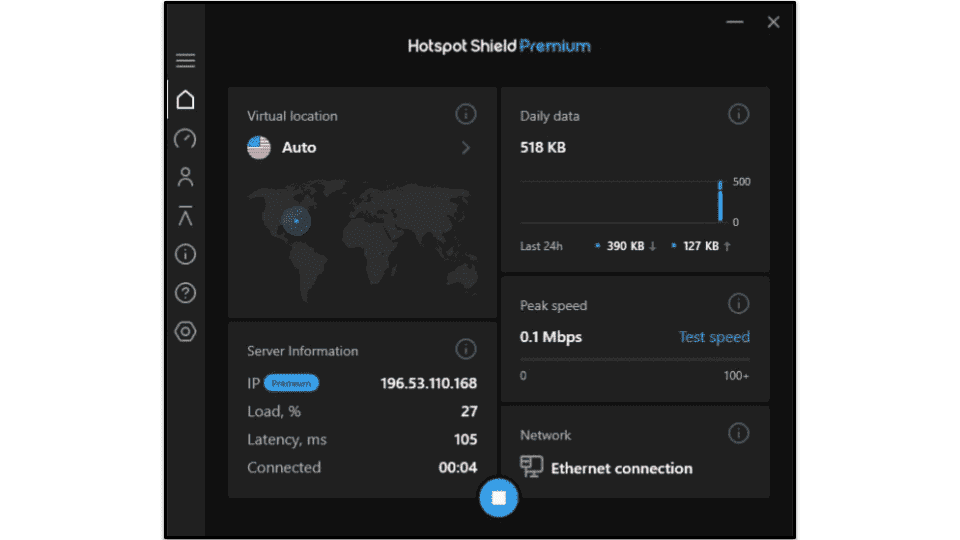
I spent a few weeks testing and researching Hotspot Shield to see how it ranks among the top VPNs on the market.
Hotspot Shield is known for its proprietary Hydra protocol, which provides super-fast speeds, strong security, and good streaming capabilities — it accesses Netflix and Amazon Prime without any issues and provides fast speeds, so all videos load instantly and there aren’t any interruptions.
Hotspot Shield also has other perks, like easy-to-use and intuitive apps, great torrenting support, some cool extra features like split-tunneling and a built-in speed test, and a good server network.
Hotspot Shield Plans & Pricing — Offers Competitive Prices + Decent Free Plan
Hotspot Shield has a decent free plan and 2 premium subscription plans that include different features.
The Basic plan is Hotspot Shield’s free plan — you get unlimited data, access to 3 server locations (the US, the UK, and Singapore) and 1 connection. Also, it’s ad-supported, so you have to watch ads in the app to use it, and it caps connection speeds at 2Mbps (but it only reduced my speed by 45%, which is pretty good for a free plan).
In addition, Hotspot Shield shares Basic users’ geo-location with advertisers, doesn’t support streaming and doesn’t have 24/7 live chat. It’s only available on Android, iOS, Windows, and macOS, and it has an extension for Chrome.
Proton VPN has one of the best free VPN plans out there — it also has unlimited bandwidth and provides access to servers in 3 countries (the US, Netherlands, and Japan), but it offers faster speeds, is ad-free, and doesn’t store or share any user information.
Hotspot Shield’s Premium plan is available as a 1-month subscription ($9.99 / month) or a 1-year subscription ($6.66 / month). Each plan allows up to 10 connections, comes with access to servers in 85 countries, the fastest speeds, full streaming support, 24/7 live chat, and also supports Linux, routers, and smart TVs.
Hotspot Shield accepts 6 types of credit cards and PayPal but cryptocurrency payments aren’t available. If you want a low-cost VPN that accepts crypto, I recommend Private Internet Access.
Hotspot Shield backs all plans with a very generous 45-day money-back guarantee (most VPNs only offer 30-day refunds). CyberGhost VPN also has a 45-day money-back guarantee but only for its long-term plans.
Overall, Hotspot Shield has a decent free plan and flexible paid plans.
Hotspot Shield Features — Comes With Essential VPN Security Features
Hotspot Shield has the following security features:
- 256-bit AES encryption — Hotspot Shield uses military-grade encryption to protect your data.
- No-logs policy — Hotspot Shield doesn’t log your IP address, websites you visit, and files you download. However, if you use the free plan, Hotspot Shield uses your IP to determine your geo-location.
- Kill switch — Hotspot Shield disables internet traffic if your VPN connection drops.
Hotspot Shield has DNS leak protection on all platforms, but IPv6 and WebRTC leak protection are available only on Windows. Other top VPNs like ExpressVPN and Private Internet Access have built-in IPv6 and WebRTC leak protection on more apps, including even on browser extensions.
One of my favorite things about Hotspot Shield is its proprietary Hydra protocol, which is available on iOS, Android, Windows, and macOS. Hydra includes:
- Excellent security — Hydra is based on OpenVPN and uses high-level security to protect your data as it travels through the VPN tunnel.
- Fast speeds — Hotspot Shield claims Hydra is more than twice as fast as OpenVPN.
- Obfuscation — Hydra helps hide your VPN traffic from your internet service provider (ISP) and sometimes even bypasses internet firewalls in censor-heavy nations like China and Iran.
- Perfect forward secrecy — This feature changes your encryption keys at regular intervals during your VPN session, meaning that even if a hacker compromises one encryption key, they can’t crack previous or future keys.
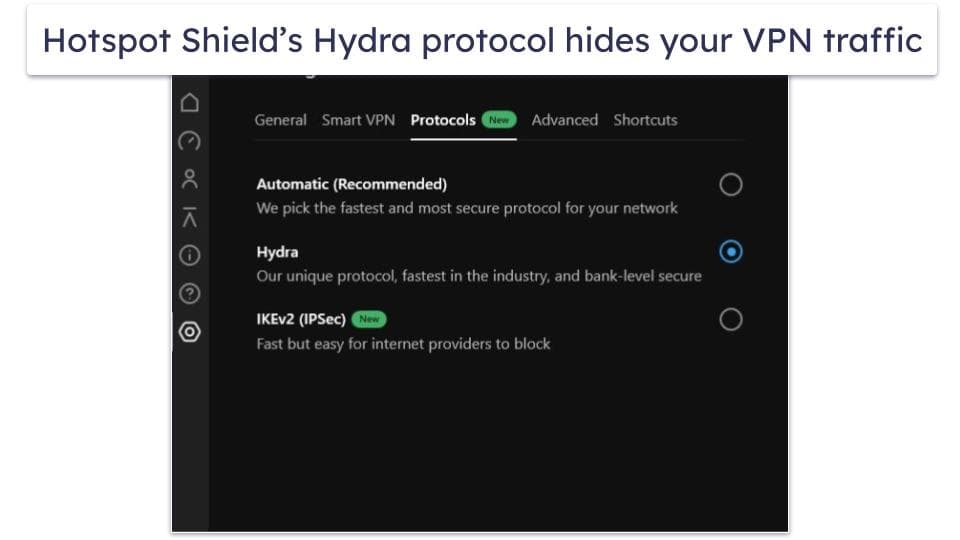
In addition to Hydra, Hotspot Shield also uses other protocols — IKEv2/IPSec and WireGuard.
Hotspot Shield supports The Onion Router (Tor) on all servers. A Tor over VPN connection is safer than regular Tor connections because a VPN protects you from possible IP leaks during your Tor session (IP leaks are rare on the Tor network, but they can happen). If your IP address is accidentally leaked, only the VPN’s IP address will be exposed, and not your actual IP address. Hotspot Shield has good Tor support, but I prefer the convenience that Proton VPN provides — it lets you browse Tor sites in regular browsers like Chrome, Firefox, and Opera. Keep in mind Tor over VPN connections are slower because your data is encrypted multiple times. On average, I had a 97% slowdown while using Tor with Hotspot Shield (the slowdown is on par with other VPNs).
Hotspot Shield also offers other features, including split-tunneling and a built-in speed test.
Split-Tunneling (Smart VPN) — Routes Apps & Sites via the VPN or Local Network
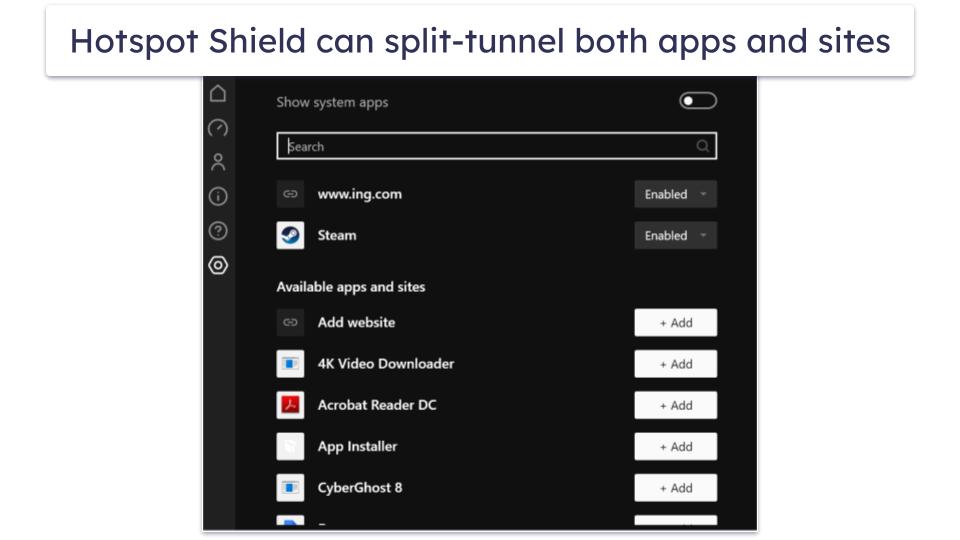
Hotspot Shield has good split-tunneling that lets you exclude apps and/or websites outside the VPN tunnel. When I tested Hotspot Shield’s split-tunneling feature, I connected to a VPN server in my home country (Romania) to download a file, and I routed my bank’s website through my local network (many banks block VPNs).
The split-tunneling feature is available on Android, iOS, Windows, and macOS. This is impressive considering not a lot of VPNs offer this feature on iOS or macOS, though ExpressVPN and Private Internet Access both have split-tunneling for Macs.
On Android, Hotspot Shield lets you route specific apps through the VPN tunnel and exclude apps and sites from the VPN connection. I tested this feature on Android by routing all my browser traffic through the VPN, and it always worked as intended.
For Windows, Hotspot Shield lets you exclude apps and websites and choose which sites you want to use the VPN connection.
On iOS and macOS devices, Hotspot Shield only lets you split-tunnel websites. This means you can choose which sites go outside the VPN tunnel and which sites are routed through the VPN tunnel.
Overall, Hotspot Shield has good split-tunneling on all OS — it’s intuitive and works as expected.
Built-in Speed Test — Convenient & Accurate Tool (But It’s Only Available on Windows)
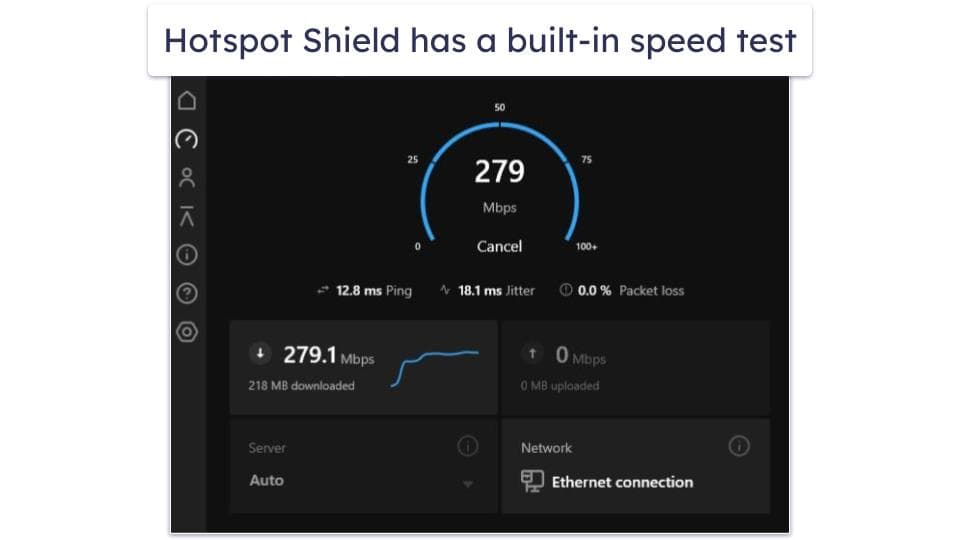
Hotspot Shield has a useful and accurate built-in speed test that you can use to quickly determine your VPN speeds and your ISP’s speeds. You can use the speed test before connecting to a VPN server to get a baseline of your speeds, and you can also run the speed test while connected to a VPN server to see how much Hotspot Shield decreases your speed.
In my tests, Hotspot Shield’s speed test results were accurate — they were always about the same as the results of speed tests I conducted using third-party speed test site Ookla.
I like this feature since it’s more convenient to run speed tests inside the app than on third-party sites — but I wish Hotspot Shield ranked its fastest servers to help you find the fastest server for your location. Also, Hotspot Shield’s speed test is only available on Windows, and I’d like to see it added to other apps.
Overall, I like Hotspot Shield’s built-in speed test. It’s very accurate, easy to use, and convenient.
Hotspot Shield Privacy & Security — It Has a No-Logs Policy, but It’s Not Verified
Hotspot Shield doesn’t log your online traffic or the files that you download. However, if you use the free plan, Hotspot Shield uses your IP address to determine your geo-location and shares it with advertisers who target you with annoying location-specific ads.
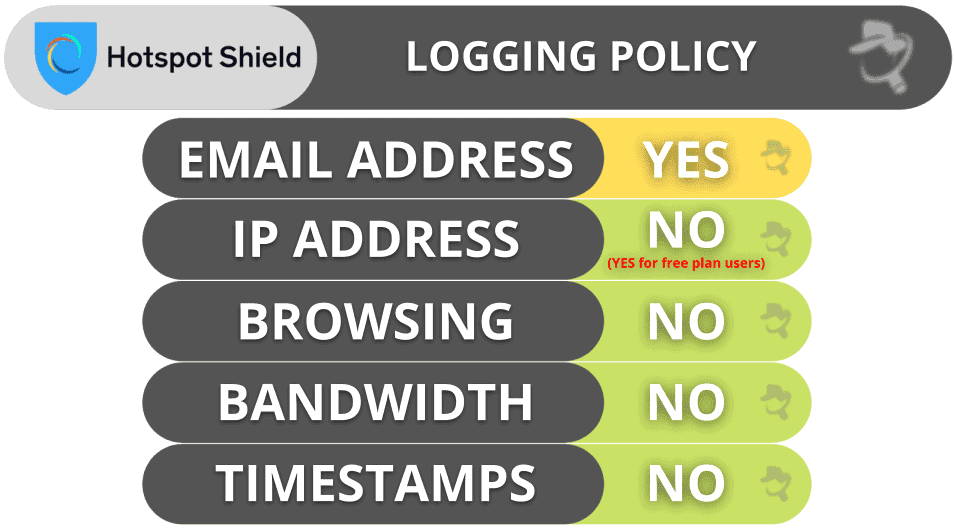
Hotspot Shield is headquartered in the US, which is part of the 5/9/14 Eyes Alliances (a group of countries that share intelligence data). But Hotspot Shield doesn’t log your data, so even if US authorities ask Hotspot Shield to hand over user data, it won’t have anything to share. That being said, Hotspot Shield hasn’t conducted an independent audit to verify its no-logs policy, and I hope it takes this action in the near future. Private Internet Access is also based in the US and hasn’t conducted an independent audit, but its no-logs policy has been proven true multiple times in court documents.
Overall, Hotspot Shield has a transparent no-logs policy. It uses your IP to determine your geo-location, but only on the free plan (it doesn’t log premium users’ IP addresses).
Hotspot Shield Speed & Performance — Blazing Fast Speeds With Hydra Protocol
I ran speed tests in all 85 countries where Hotspot Shield has a server and experienced a 70% speed decrease on average. This isn’t ideal, but I live in a country (Romania) that has very fast internet speeds. While I experienced significant speed loss in my test results, I maintained fast speeds for browsing, streaming, torrenting, and for making Voice over IP (VoIP) calls.
My co-worker in the US also ran speed tests for Hotspot Shield to see how his speeds compared, and his speed decreased by about 10% on local servers. However, my colleague’s speeds in the US were faster on distant servers than his speeds without a VPN connection, which is really impressive.
I first ran a speed test without being connected to Hotspot Shield to get a baseline for my speeds:

Next, I manually connected to a VPN server in Romania. Hotspot Shield has a quick-connect feature called “Auto,” but, unlike other VPNs that include this tool, Auto only connects you to the fastest server in the US. This is really inconvenient for non-US users, but at least my speeds were still fast in the US. On the Romanian server, my speeds decreased by 69%, but my online browsing remained unchanged. Websites and HD and 4K videos loaded instantly, and I was able to skip through shows and movies in HD without experiencing any buffering.

Next, I connected to a server in the US using both the Auto feature and by manually connecting to one, but I didn’t notice any major differences in speed loss — I still experienced about a 72% slowdown and had good speeds. Websites, 4K videos, and HD videos still loaded instantly, but there was minor buffering while skipping through 4K and HD videos. I downloaded large torrents very fast (49 GB files in 20–30 minutes), played online video games without lag, and my Voice over IP (VoIP) calls were stable.

Finally, I ran a speed test on a server in Japan. The slowdown was the same as on the US server (72%), and the speeds for my online activities were also about the same as in the US. Websites continued to load instantly, but 4K videos took 3–5 seconds to load and there was minor buffering while skipping through them. However, HD videos loaded instantly and didn’t buffer at all. I still downloaded large torrents fast, and I didn’t experience any freezing during my VoIP calls.

But my country (Romania) has very fast internet speeds. It’s not fair to compare my results with what people from other countries see, so I also asked my colleague in the US to run speed tests.
First, my colleague ran a test connected to his local network to get a baseline of his speeds.

Then, he used Hotspot Shield’s Auto quick-connect feature to connect to the fastest server, which was in New York City. His speed decreased by 8%, and the difference in speeds for all of his online activity was barely noticeable.

When he connected to a server in Italy, his speeds were shockingly faster than they were without a VPN connection. His websites loaded practically right away, videos started in 1–2 seconds and he didn’t have any buffering, and he was able to download files at about the same speeds as he did while connected to a US server.

Finally, he connected to a server in Australia. While his ping was very high, his download speed was even faster than his speeds in Italy — he still maintained really good speeds for browsing and streaming (websites took 1–2 seconds to load and TV shows and movies also started almost instantly). His international VoIP call was crisp and clear, and he didn’t suffer any interruptions.

Overall, Hotspot Shield has some of the fastest speeds on the market. My colleague and I had fast speeds for streaming (both of us only experienced minor buffering), browsing, gaming, and torrenting.
Hotspot Shield Servers & IP Addresses — Pretty Big Network + Dedicated Streaming & Gaming Servers
Hotspot Shield has 3,200+ servers in 85 countries. Hotspot Shield’s server network is not as big as CyberGhost VPN (servers in 100 countries), but Hotspot Shield has a larger network than TunnelBear (47 countries). And Hotspot Shield’s servers are evenly spread across the globe in Europe, the Americas, Asia Pacific, the Middle East, and Africa.
I like how Hotspot Shield allows you to choose between a server in 25+ US cities — you can pick a US server that’s closest to you to get faster speeds.
I like that Hotspot Shield shows you the server load percentage (how many active users are connected to a server) and latency, which shows how long it takes data to travel from your device to the server — but you can only see this information after you connect to a server. These convenient tools would be more useful if they were displayed in the list of servers before you connected to a server. Proton VPN shows you the server load beforehand, and Private Internet Access and Surfshark show you the ping next to the servers before you connect to one of them.
Hotspot Shield also has dedicated streaming and gaming servers in the US and UK, which always work with Netflix and BBC iPlayer, and there are dedicated social media servers in the US for Android. The gaming servers are optimized to offer fast speeds, but I didn’t notice any difference in the speed on the dedicated servers than Hotspot Shield’s regular servers while gaming — they were all fast. The social media servers on Android are configured to provide fast connection speeds, but like with the dedicated gaming servers, I didn’t notice any difference.
Hotspot Shield supports torrenting on all of its servers, which allows you to find a nearby server for fast downloading speeds.
Overall, Hotspot Shield has a pretty big server network with locations in many countries. There are dedicated streaming, gaming, and social media servers, but they provide similar speeds as the normal servers. Also, Hotspot Shield allows torrenting on all servers.
Hotspot Shield Streaming & Torrenting — Good for Both Online Activities
Hotspot Shield is really good for streaming — it works with Netflix, Amazon Prime, Disney+, Hulu, and BBC iPlayer, as well as with less-popular sites like VRV, Crunchyroll, and Sony Crackle. I still prefer ExpressVPN though, as it works with 100+ streaming services.
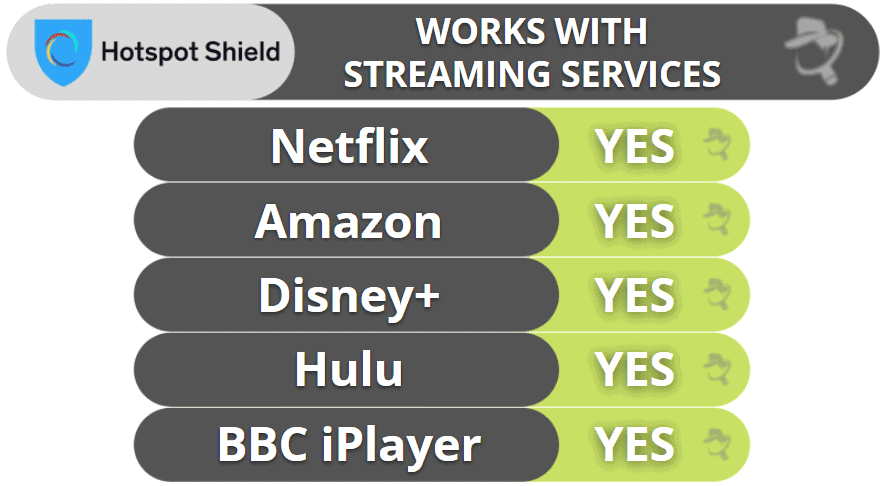
Hotspot Shield is great for torrenting. It allows P2P traffic on every server and works with all major torrenting clients (Vuze, qBittorrent, uTorrent, Deluge, and more). Unlike Private Internet Access, Hotspot Shield doesn’t support port forwarding (when you connect to more peers for faster speeds), but it allows seeding (when you upload a torrent after you finish downloading it). Before downloading any torrents, I ran leak tests on 10+ server locations — I never saw any leaks.
Overall, Hotspot Shield is excellent for streaming and torrenting. It works with popular sites like Netflix, BBC iPlayer, and Amazon Prime. Also, it supports P2P traffic on every server and works with all major torrenting clients.
Hotspot Shield Bypassing Censorship — It Might Work in China, Iran & Other Restricted Locations
Hotspot Shield doesn’t always work in restrictive countries. It says that it only works sometimes in censor-heavy nations like China and Indonesia. If you’re looking for a reliable VPN that works in restrictive countries, I recommend using ExpressVPN.
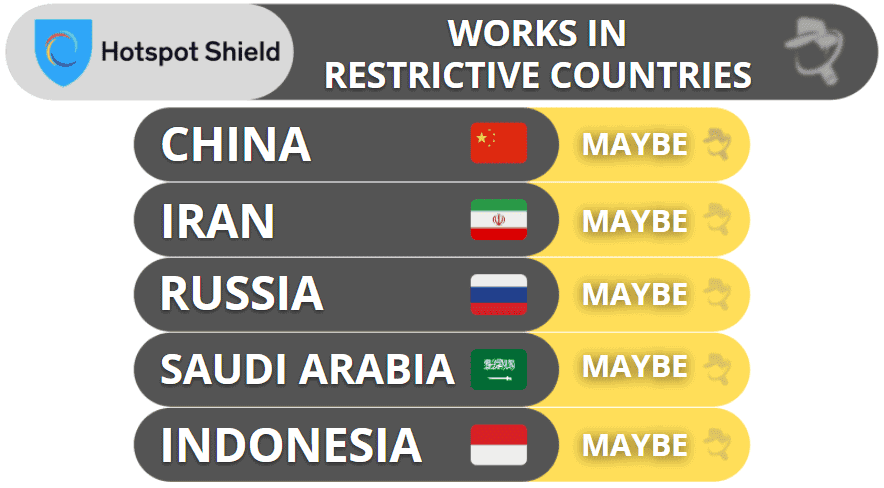
Hotspot Shield Ease of Use: Mobile & Desktop Apps — Simple & Fast Installation
Hotspot Shield has easy-to-use apps for Android, iOS, Windows, macOS, Linux, smart TVs, and Chrome. I installed the iOS and Android apps on my smartphones in 1 minute, and the macOS and Windows apps on my MacBook Pro and Windows 11 PC in 1–2 minutes.
How to Install Hotspot Shield (Just 3 Simple Steps):
- Sign up for Hotspot Shield. Pick a plan that works for you and set up an account.
- Download and install the provider’s app. The whole process shouldn’t take more than 2 minutes.
- Run the VPN app. Simply connect to a server, and start securely surfing the web.
Android — Easy to Find & Connect to a Desired Server
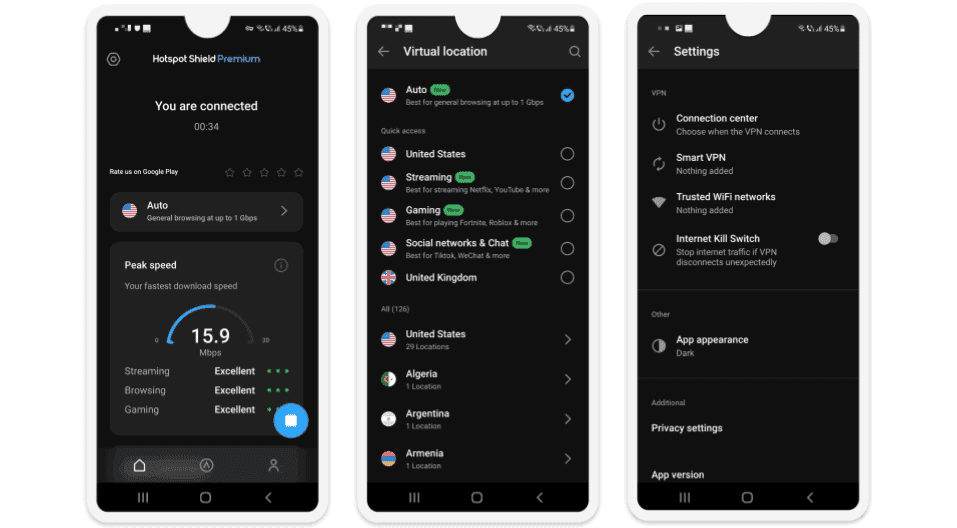
Hotspot Shield’s Android app is easy to use and has good features. It takes just 1–2 seconds to automatically connect to a server with the Auto quick-connect feature. And I like how easy it is to manually pick a server — Hotspot Shield lets you search for a location and it has a Quick access group for US and UK streaming, gaming, and social media servers. It’s really easy to access and enable/disable settings, and I also like that most settings have quick descriptions.
The Android app uses Hydra and WireGuard, has a kill switch and split-tunneling, and there are really cool automation options — for example, you can configure the VPN to connect you to a server on startup or when you launch the app and disconnect you when your Android goes to sleep. There are also options to auto-connect on secured Wi-Fi, unsecured Wi-Fi, and mobile data.
Overall, I really like Hotspot Shield’s Android app — it has an intuitive design, it’s easy to use, and it has great features (kill switch, automation options, and split-tunneling).
iOS — Fully Featured & Intuitive Design
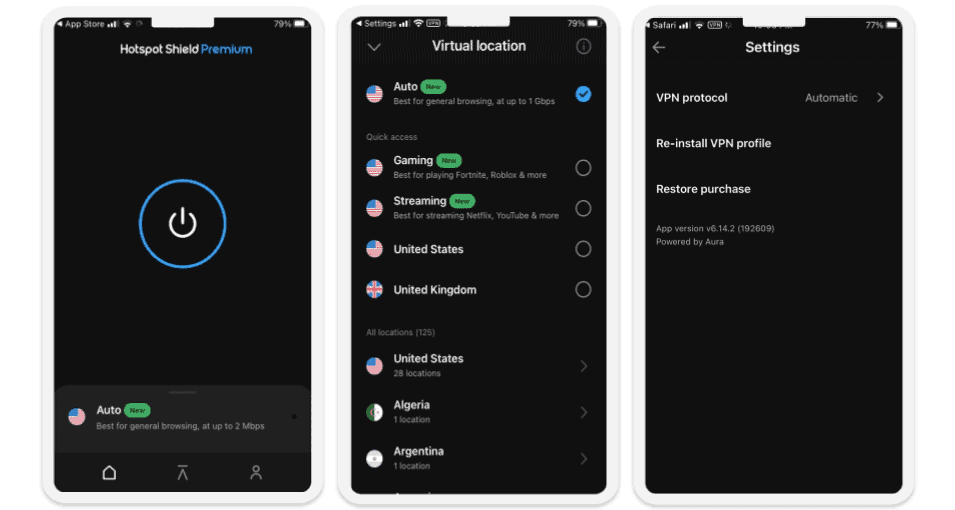
Hotspot Shield’s iOS app is easy to use and feature-rich. It’s simple to connect to a server, it lets you split-tunnel sites (most iOS apps don’t have this), and you get both Hydra and WireGuard protocols.
It lacks some of the auto-connect features that the Android app offers. But that said, it still has an Always-on VPN option that automatically reconnects you when you lose connection to the VPN server.
Overall, Hotspot Shield’s iOS app is pretty good — it comes with a great split-tunneling feature, is intuitive, and uses Hydra and WireGuard.
Windows/Mac (Desktop) — Windows App Includes More Features Than Mac
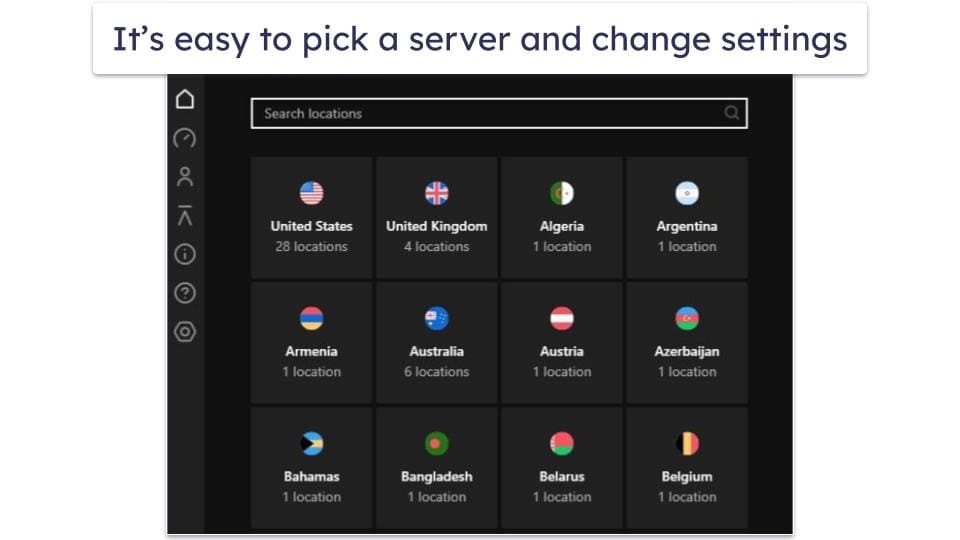
Hotspot Shield’s desktop apps have an intuitive design so they’re easy to use. There are more settings tabs and the connection screen also displays the server location on a map. Like the mobile apps, it’s very simple to manually pick a server location.
Both desktop apps are feature-rich, but the Windows app is slightly better. You get a kill switch, split-tunneling, and access to Hydra and WireGuard on both, but the Windows app has the Prevent IP leak option, which protects you from IPv6 and WebRTC leaks. It also has a pretty accurate built-in speed test, and it lets you exclude apps from the VPN tunnel (on macOS, you can only exclude sites).
Overall, Hotspot Shield’s desktop apps are easy to use, but the Windows app is more secure and has more features than the macOS app.
Hotspot Shield’s Apps: Is Hotspot Shield Easy to Use?
Hotspot Shield has user-friendly apps for iOS, Android, Windows, and macOS. The mobile apps look different than the desktop apps, but it’s still simple to switch between them.
The Windows app is my favorite — it’s the most feature-rich app with a kill switch, split-tunneling, built-in speed test, and IPv6 and WebRTC leak protection. The Android and iOS apps are both easy to use and come with pretty great features like a kill switch and split-tunneling.
| Android | iOS | Windows | macOS | Linux | |
| Graphical User Interface (GUI) | ✅ | ✅ | ✅ | ✅ | ❌ |
| Kill Switch | ✅ | ✅ | ✅ | ✅ | ❌ |
| Split-Tunneling | ✅ | ✅ | ✅ | ✅ | ❌ |
| Built-in Speed Test | ❌ | ❌ | ✅ | ❌ | ❌ |
Hotspot Shield Customer Support — Offers Helpful Platforms (But Live Chat Is Only Available on Paid Plans)
Hotspot Shield provides very good customer support via an in-depth and well-organized support section with useful frequently asked questions (FAQs), setup tutorials, and troubleshooting guides. There’s also 24/7 live chat (only available for the paid plans) and email support.
I really like the support library — it has a search function and splits the FAQs and support guides into device-specific sections. There’s also a dedicated section for payments and subscriptions, account management, and troubleshooting issues. Hotspot Shield’s support articles have good information and helpful screenshots, but they don’t have video guides like ExpressVPN and IPVanish.
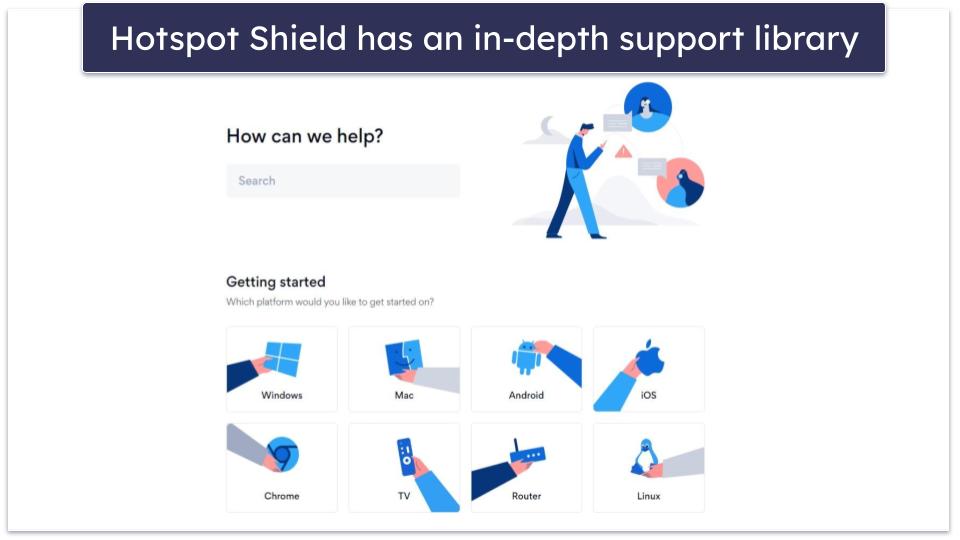
Connecting to a live chat representative typically took under 10 seconds. The agents were resourceful, well-informed, and usually addressed all my questions. Live chat is primarily in English, but the reps can use a translation tool to help in any other language.
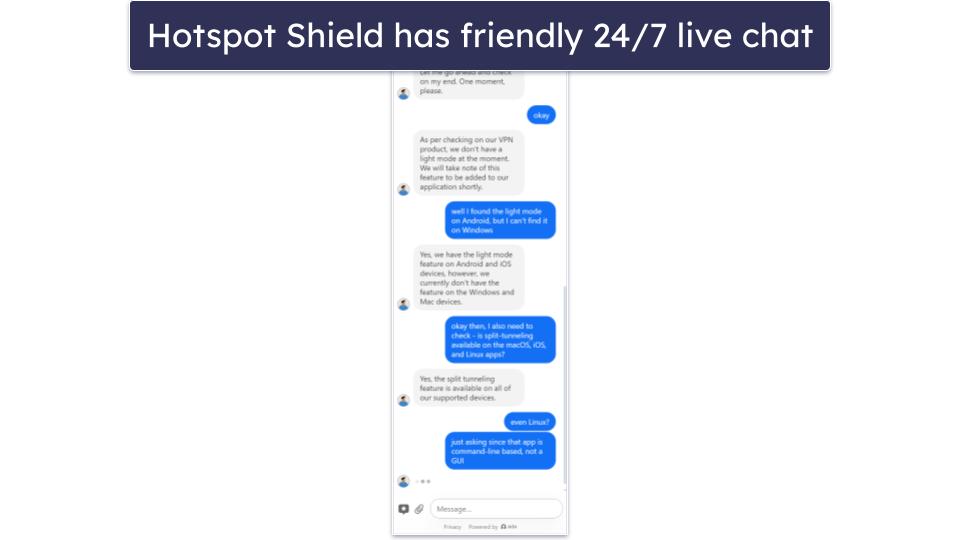
I also tested Hotspot Shield’s email support. The reps usually replied in 4–5 hours, which is pretty good, and they thoroughly answered all my questions.
Overall, Hotspot Shield has very good customer support — the support library is in-depth and reader-friendly, and the live chat reps and email support are responsive and knowledgeable.
Is Hotspot Shield Fast & Good for Streaming in 2025?
Hotspot Shield is great for streaming, very fast, easy to use, and secure. It has 3,200+ servers in 85 countries and intuitive apps for iOS, Android, Windows, macOS, Linux, and smart TVs.
In my tests, Hotspot Shield provided me with lightning-fast fast speeds for streaming, torrenting, browsing, and gaming on local and distant servers.
Hotspot Shield has industry-standard VPN security features like 256-bit AES encryption, a no-logs policy, secure protocols, and a kill switch. It also has extra features like split-tunneling, obfuscation, perfect forward secrecy, and Tor support.
Hotspot Shield is a great VPN, but it’s missing some important features on some apps. IPv6 and WebRTC leak protection is only available on Windows, the VPN doesn’t always work in restrictive countries like China, and while there’s a quick-connect feature, it only connects you to US servers. And it’s one of the more expensive VPNs on the market in 2025.
Hotspot Shield has a decent free plan and 3 premium plans. All plans are covered by a 45-day money-back guarantee.
Frequently Asked Questions
Is Hotspot Shield free?
Yes, Hotspot Shield has a free plan, but frankly there are better free VPNs out there. The free plan offers unlimited data, allows access to 3 server locations (the US, the UK, and Singapore), and lets you connect 1 device, which is pretty good for a free plan. But it also caps your connection speed at 2Mbps, and there’s no streaming support or 24/7 live chat. The worst part of Hotspot Shield’s free plan is that it shares your geo-location with advertisers, meaning you’ll see more location-specific ads.
Upgrading to the provider’s paid plans provides more perks, including access to servers in 85 countries, 10 connections, fast speeds, and streaming support. All purchases are covered by a 45-day money-back guarantee.
Is Hotspot Shield good for torrenting?
Yes, Hotspot Shield is great for torrenting. It allows P2P traffic on all of its 3,200+ servers, works with the most popular torrent clients, and it has very fast download speeds (I downloaded 49 GB files in 20–30 minutes). It also has a kill switch and didn’t leak my data in my tests. That said, there are much better torrenting VPNs out there.
Does Hotspot Shield keep logs?
Hotspot Shield has a strict no-logs policy that doesn’t log the websites you visit, files you download, and your IP address. However, if you subscribe to the free plan, Hotspot Shield uses your IP address to determine your geo-location, which it shares with advertisers to target you with location-specific ads. Also, Hotspot Shield’s no-logs policy hasn’t been independently audited. If you want a VPN with an audited no-logs policy, I recommend ExpressVPN.
Does Hotspot Shield work with Netflix?
Yes, Hotspot Shield works with Netflix, but only on the paid plans. Hotspot Shield also has really fast speeds, which allow for uninterrupted streaming. While HotSpot Shield is a good streaming VPN, my favorite VPN that works with Netflix is ExpressVPN — it has excellent security, blazing-fast speeds, and can access all streaming sites 100% of the time.


